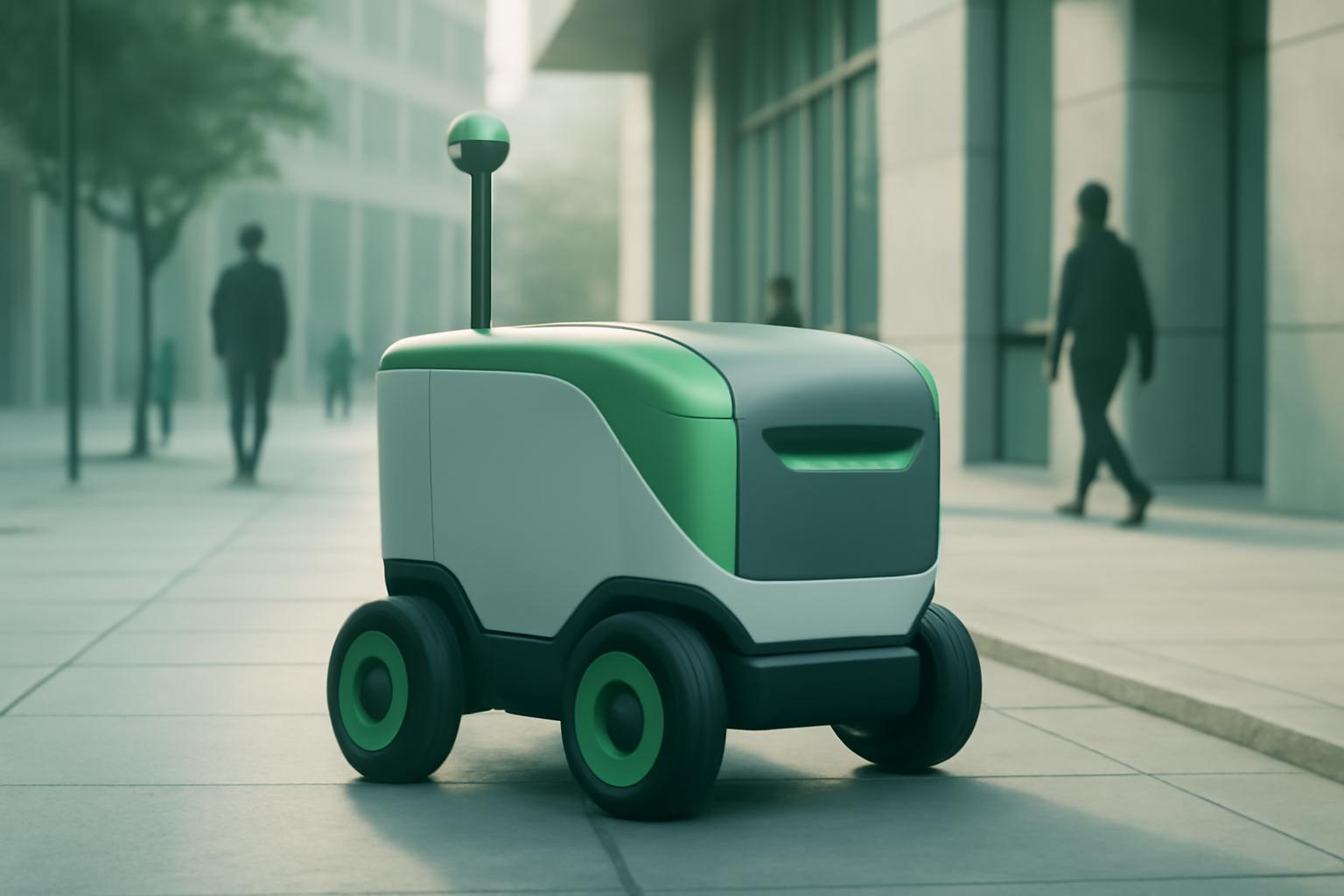DoorDash’s launch of Dot represents a strategic move to enhance delivery efficiency and reduce operational costs through autonomous technology. The robot’s ability to navigate complex urban environments and improve order accuracy positions DoorDash at the forefront of innovation in last-mile delivery. !-- wp:paragraph -->
- Opportunities: Expansion into new markets with scalable autonomous delivery solutions; reduction in delivery costs; improved customer satisfaction through enhanced order accuracy.
- Risks: Regulatory challenges related to autonomous vehicles; technological hurdles in diverse urban environments; potential customer acceptance barriers.
FinOracleAI — Market View
DoorDash’s launch of Dot represents a strategic move to enhance delivery efficiency and reduce operational costs through autonomous technology. The robot’s ability to navigate complex urban environments and improve order accuracy positions DoorDash at the forefront of innovation in last-mile delivery. !-- wp:paragraph -->- Opportunities: Expansion into new markets with scalable autonomous delivery solutions; reduction in delivery costs; improved customer satisfaction through enhanced order accuracy.
- Risks: Regulatory challenges related to autonomous vehicles; technological hurdles in diverse urban environments; potential customer acceptance barriers.
“The scale and complexity of the business demands something like autonomy, and there isn’t anything out there that fits our use case,” said Stanley Tang, DoorDash co-founder and head of DoorDash Labs automation and robotics unit.
Context: Autonomous Delivery in the Food Industry
DoorDash’s introduction of Dot follows a broader industry trend toward autonomous delivery solutions. Competitors like Uber recently announced a partnership with Israeli drone startup Flytrex and have experimented with self-driving Waymo vehicles for food delivery. These advancements indicate a growing emphasis on automation to improve efficiency and meet increasing consumer demand. !-- wp:paragraph -->FinOracleAI — Market View
DoorDash’s launch of Dot represents a strategic move to enhance delivery efficiency and reduce operational costs through autonomous technology. The robot’s ability to navigate complex urban environments and improve order accuracy positions DoorDash at the forefront of innovation in last-mile delivery. !-- wp:paragraph -->- Opportunities: Expansion into new markets with scalable autonomous delivery solutions; reduction in delivery costs; improved customer satisfaction through enhanced order accuracy.
- Risks: Regulatory challenges related to autonomous vehicles; technological hurdles in diverse urban environments; potential customer acceptance barriers.
Current Deployment and Future Expansion Plans
Dot is currently being tested in Phoenix, Arizona, where it is available to local merchants through DoorDash’s new autonomous delivery platform. The platform also integrates drone delivery services where applicable. DoorDash plans to expand Dot’s deployment to additional metropolitan areas as the technology matures. !-- wp:paragraph -->“The scale and complexity of the business demands something like autonomy, and there isn’t anything out there that fits our use case,” said Stanley Tang, DoorDash co-founder and head of DoorDash Labs automation and robotics unit.
Context: Autonomous Delivery in the Food Industry
DoorDash’s introduction of Dot follows a broader industry trend toward autonomous delivery solutions. Competitors like Uber recently announced a partnership with Israeli drone startup Flytrex and have experimented with self-driving Waymo vehicles for food delivery. These advancements indicate a growing emphasis on automation to improve efficiency and meet increasing consumer demand. !-- wp:paragraph -->FinOracleAI — Market View
DoorDash’s launch of Dot represents a strategic move to enhance delivery efficiency and reduce operational costs through autonomous technology. The robot’s ability to navigate complex urban environments and improve order accuracy positions DoorDash at the forefront of innovation in last-mile delivery. !-- wp:paragraph -->- Opportunities: Expansion into new markets with scalable autonomous delivery solutions; reduction in delivery costs; improved customer satisfaction through enhanced order accuracy.
- Risks: Regulatory challenges related to autonomous vehicles; technological hurdles in diverse urban environments; potential customer acceptance barriers.
Current Deployment and Future Expansion Plans
Dot is currently being tested in Phoenix, Arizona, where it is available to local merchants through DoorDash’s new autonomous delivery platform. The platform also integrates drone delivery services where applicable. DoorDash plans to expand Dot’s deployment to additional metropolitan areas as the technology matures. !-- wp:paragraph -->“The scale and complexity of the business demands something like autonomy, and there isn’t anything out there that fits our use case,” said Stanley Tang, DoorDash co-founder and head of DoorDash Labs automation and robotics unit.
Context: Autonomous Delivery in the Food Industry
DoorDash’s introduction of Dot follows a broader industry trend toward autonomous delivery solutions. Competitors like Uber recently announced a partnership with Israeli drone startup Flytrex and have experimented with self-driving Waymo vehicles for food delivery. These advancements indicate a growing emphasis on automation to improve efficiency and meet increasing consumer demand. !-- wp:paragraph -->FinOracleAI — Market View
DoorDash’s launch of Dot represents a strategic move to enhance delivery efficiency and reduce operational costs through autonomous technology. The robot’s ability to navigate complex urban environments and improve order accuracy positions DoorDash at the forefront of innovation in last-mile delivery. !-- wp:paragraph -->- Opportunities: Expansion into new markets with scalable autonomous delivery solutions; reduction in delivery costs; improved customer satisfaction through enhanced order accuracy.
- Risks: Regulatory challenges related to autonomous vehicles; technological hurdles in diverse urban environments; potential customer acceptance barriers.
Advanced Technology and Delivery Capabilities
Dot is engineered to meet the demands of complex delivery logistics. It can travel up to 20 miles per hour and carry loads up to 30 pounds, equivalent to six pizza boxes. To safely maneuver through congested urban settings, Dot is equipped with eight cameras and three lidar sensors, enabling it to detect obstacles such as crowded parking lots, blocked bike lanes, and busy streets. !-- wp:paragraph --> An internal camera monitors food quality during transit, while a smart scale feature weighs orders to detect missing items. DoorDash reports that this innovation has reduced complaints about missing items by up to 30% in testing phases. !-- wp:paragraph -->Current Deployment and Future Expansion Plans
Dot is currently being tested in Phoenix, Arizona, where it is available to local merchants through DoorDash’s new autonomous delivery platform. The platform also integrates drone delivery services where applicable. DoorDash plans to expand Dot’s deployment to additional metropolitan areas as the technology matures. !-- wp:paragraph -->“The scale and complexity of the business demands something like autonomy, and there isn’t anything out there that fits our use case,” said Stanley Tang, DoorDash co-founder and head of DoorDash Labs automation and robotics unit.
Context: Autonomous Delivery in the Food Industry
DoorDash’s introduction of Dot follows a broader industry trend toward autonomous delivery solutions. Competitors like Uber recently announced a partnership with Israeli drone startup Flytrex and have experimented with self-driving Waymo vehicles for food delivery. These advancements indicate a growing emphasis on automation to improve efficiency and meet increasing consumer demand. !-- wp:paragraph -->FinOracleAI — Market View
DoorDash’s launch of Dot represents a strategic move to enhance delivery efficiency and reduce operational costs through autonomous technology. The robot’s ability to navigate complex urban environments and improve order accuracy positions DoorDash at the forefront of innovation in last-mile delivery. !-- wp:paragraph -->- Opportunities: Expansion into new markets with scalable autonomous delivery solutions; reduction in delivery costs; improved customer satisfaction through enhanced order accuracy.
- Risks: Regulatory challenges related to autonomous vehicles; technological hurdles in diverse urban environments; potential customer acceptance barriers.
DoorDash Introduces ‘Dot’ Autonomous Delivery Robot
DoorDash has officially launched an autonomous delivery robot named Dot, designed to navigate busy urban environments including streets, sidewalks, and parking lots to deliver food directly to customers. This marks DoorDash’s first standalone venture into autonomous vehicle technology, expanding its innovation beyond previous drone tests and partnerships. !-- wp:paragraph -->Advanced Technology and Delivery Capabilities
Dot is engineered to meet the demands of complex delivery logistics. It can travel up to 20 miles per hour and carry loads up to 30 pounds, equivalent to six pizza boxes. To safely maneuver through congested urban settings, Dot is equipped with eight cameras and three lidar sensors, enabling it to detect obstacles such as crowded parking lots, blocked bike lanes, and busy streets. !-- wp:paragraph --> An internal camera monitors food quality during transit, while a smart scale feature weighs orders to detect missing items. DoorDash reports that this innovation has reduced complaints about missing items by up to 30% in testing phases. !-- wp:paragraph -->Current Deployment and Future Expansion Plans
Dot is currently being tested in Phoenix, Arizona, where it is available to local merchants through DoorDash’s new autonomous delivery platform. The platform also integrates drone delivery services where applicable. DoorDash plans to expand Dot’s deployment to additional metropolitan areas as the technology matures. !-- wp:paragraph -->“The scale and complexity of the business demands something like autonomy, and there isn’t anything out there that fits our use case,” said Stanley Tang, DoorDash co-founder and head of DoorDash Labs automation and robotics unit.
Context: Autonomous Delivery in the Food Industry
DoorDash’s introduction of Dot follows a broader industry trend toward autonomous delivery solutions. Competitors like Uber recently announced a partnership with Israeli drone startup Flytrex and have experimented with self-driving Waymo vehicles for food delivery. These advancements indicate a growing emphasis on automation to improve efficiency and meet increasing consumer demand. !-- wp:paragraph -->FinOracleAI — Market View
DoorDash’s launch of Dot represents a strategic move to enhance delivery efficiency and reduce operational costs through autonomous technology. The robot’s ability to navigate complex urban environments and improve order accuracy positions DoorDash at the forefront of innovation in last-mile delivery. !-- wp:paragraph -->- Opportunities: Expansion into new markets with scalable autonomous delivery solutions; reduction in delivery costs; improved customer satisfaction through enhanced order accuracy.
- Risks: Regulatory challenges related to autonomous vehicles; technological hurdles in diverse urban environments; potential customer acceptance barriers.













